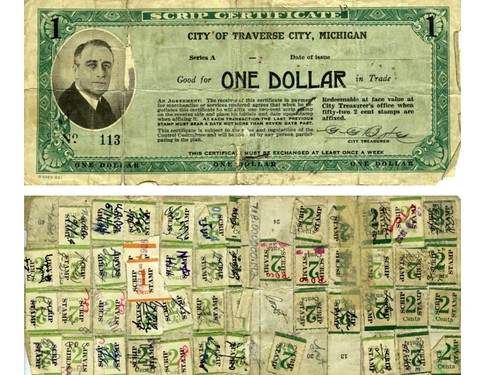
PREV ARTICLE
NEXT ARTICLE
FULL ISSUE
PREV FULL ISSUE
TRAVERSE DOLLARSI didn't get a chance to mention this one earlier; I discovered it via the News & Notes newsletter from the Society of Paper Money Collectors (Volume V, Number 49, May 26, 2020). -Editor 
During the Great Depression, some banks were closing temporarily and others failing completely. There was little money in the hands of the people, and given the uncertainty about their prospects of getting more of it, people tended to hoard what little they had. The short supply of U.S. dollars in the 1930s meant there was a need to come up with another way for trade to keep the economy going -- leading to the idea of local currencies, known across the country as Depression scrip. In effect, it was a local bartering system, easier than exchanging goods or services, and used across a broad base of stores and services. And here this region, residents traded Traverse Dollars. Local historian Richard Fidler notes the use of scrip was encouraged by no less than President Franklin Roosevelt. "The purpose was to get people spending again, not just hide money under the mattress," he says. Fidler explains they were issued in 1934 and could be redeemed at many Traverse City businesses in exchange for goods. At one point, local teachers were even paid in scrip, since there was no other money available for them. So what were the stamps all over the backs of Traverse Dollars for? According to DepressionScrip.com, the fact that there was little money in the hands of the people and there was great uncertainty about the prospects of getting more of it, people tended to hoard whatever money they did have. So to ensure wide distribution and use, the dollars had to be used on a weekly basis or they would lose value. So the stamps were a way to make sure the Traverse Dollars were circulated. According to Cathy Schmitt, who first brought them to The Ticker's attention, the money would decay by two cents a day unless you put a two-cent stamp on it and signed and dated it. So the incentive was to spend as fast as you could, she says. The article also discusses a 2005 effort that created a similar community currency called Bay Bucks. -Editor
To read the complete article, see:

Wayne Homren, Editor The Numismatic Bibliomania Society is a non-profit organization promoting numismatic literature. See our web site at coinbooks.org. To submit items for publication in The E-Sylum, write to the Editor at this address: whomren@gmail.com To subscribe go to: https://my.binhost.com/lists/listinfo/esylum All Rights Reserved. NBS Home Page Contact the NBS webmaster 
|